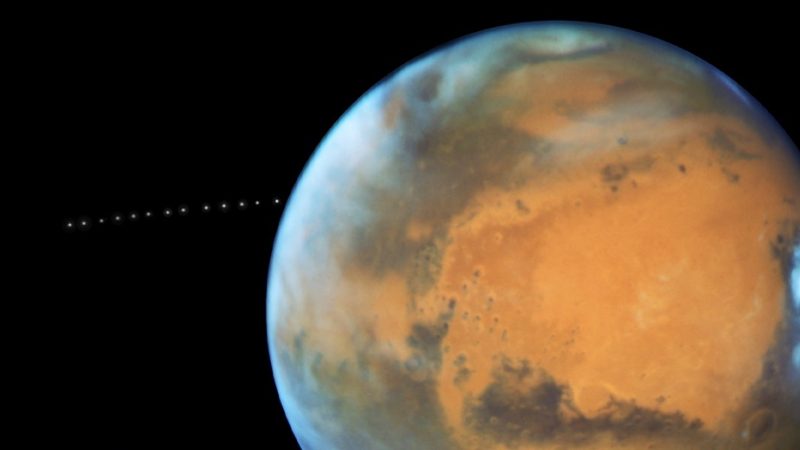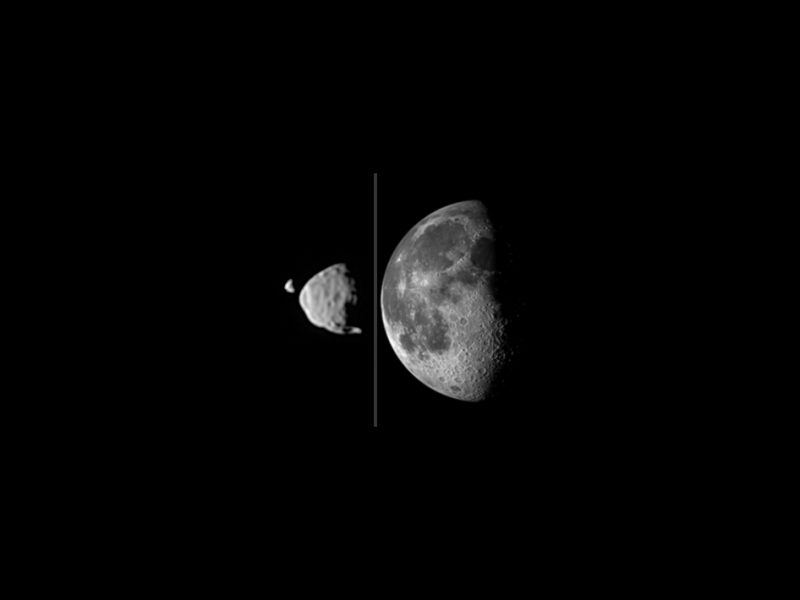

Discovered in 1877, the larger of the 2 Mars moons – potato-shaped Phobos – is so small that it appears starlike in Hubble Space Telescopes pictures. The other moon, Deimos, is even smaller. Image via HubbleSite.
It’s long been suggested that Mars’ two moons – called Phobos and Deimos (Panic and Terror) for the two horses of the mythological war god Mars – are captured asteroids. After all, Mars orbits just one step inward from the asteroid belt. And the two moons resemble rocky C-type asteroids, the most common kind of asteroids, in terms of their estimated densities and reflected light. Questions have remained, however, particularly regarding the nearly circular orbits of the moons. On April 18, 2018, scientists at the Southwest Research Institute (SwRI) in Boulder, Colorado announced new work based on state-of-the-art computer modeling, suggesting an alternate origin for Mars’ moons. The work suggests a violent birth for the moons – much like mighty impact that might have formed Earth’s own moon – but on a much smaller scale.
The new work is published in the peer-reviewed journal Science Advances. Its lead author, Robin Canup, is an expert in using large-scale hydrodynamical simulations to model planet-scale collisions. She said:
Ours is the first self-consistent model to identify the type of impact needed to lead to the formation of Mars’ two small moons.
A key result of the new work is the size of the impactor; we find that a large impactor – similar in size to the largest asteroids Vesta and Ceres – is needed, rather than a giant impactor.
The model also predicts that the two moons are derived primarily from material originating in Mars, so their bulk compositions should be similar to that of Mars for most elements. However, heating of the ejecta and the low escape velocity from Mars suggests that water vapor would have been lost, implying that the moons will be dry if they formed by impact.

This composite image compares how big the moons of Mars appear, as seen from the surface of the Red Planet, in relation to the size that our moon appears from Earth’s surface. While Earth’s moon is 100 times bigger than the larger Martian moon Phobos, the Martian moons orbit much closer to their planet, making them appear relatively larger in the sky. Deimos, at far left, and Phobos, beside it, are shown together as photographed by NASA’s Mars rover Curiosity on August 1, 2013. Image via NASA/JPL-Caltech/Malin Space Science Systems/Texas A&M University/SWRI.
A statement from these scientists explained more:
The new Mars model invokes a much smaller impactor than considered previously. Our moon may have formed when a Mars-sized object crashed into the nascent Earth 4.5 billion years ago, and the resulting debris coalesced into the Earth-moon system. The Earth’s diameter is about 8,000 miles, while Mars’ diameter is just over 4,200 miles. The moon is just over 2,100 miles in diameter, about one-fourth the size of Earth.
While they formed in the same timeframe, Deimos and Phobos are very small, with diameters of only 7.5 miles and 14 miles respectively, and orbit very close to Mars. The proposed Phobos-Deimos forming impactor would be between the size of the asteroid Vesta, which has a diameter of 326 miles, and the dwarf planet Ceres, which is 587 miles wide.
These scientists say their work is particularly significant for the Japan Aerospace Exploration Agency (JAXA) Mars Moons eXploration (MMX) mission, which is planned to launch in 2024. The MMX spacecraft will visit the two Martian moons, land on the surface of Phobos and collect a surface sample to be returned to Earth in 2029. Canup said:
A primary objective of the MMX mission is to determine the origin of Mars’ moons, and having a model that predicts what the moons compositions would be if they formed by impact provides a key constraint for achieving that goal.
Bottom line: State-of-the-art computer modeling suggests Mars’ moons formed in a collision between primitive Mars and a dwarf-planet-sized body, early in the solar system’s history.
Source: Origin of Phobos and Deimos by the Impact of a Vesta-to-Ceres-sized Body with Mars
from EarthSky https://ift.tt/2HzQOAj


Discovered in 1877, the larger of the 2 Mars moons – potato-shaped Phobos – is so small that it appears starlike in Hubble Space Telescopes pictures. The other moon, Deimos, is even smaller. Image via HubbleSite.
It’s long been suggested that Mars’ two moons – called Phobos and Deimos (Panic and Terror) for the two horses of the mythological war god Mars – are captured asteroids. After all, Mars orbits just one step inward from the asteroid belt. And the two moons resemble rocky C-type asteroids, the most common kind of asteroids, in terms of their estimated densities and reflected light. Questions have remained, however, particularly regarding the nearly circular orbits of the moons. On April 18, 2018, scientists at the Southwest Research Institute (SwRI) in Boulder, Colorado announced new work based on state-of-the-art computer modeling, suggesting an alternate origin for Mars’ moons. The work suggests a violent birth for the moons – much like mighty impact that might have formed Earth’s own moon – but on a much smaller scale.
The new work is published in the peer-reviewed journal Science Advances. Its lead author, Robin Canup, is an expert in using large-scale hydrodynamical simulations to model planet-scale collisions. She said:
Ours is the first self-consistent model to identify the type of impact needed to lead to the formation of Mars’ two small moons.
A key result of the new work is the size of the impactor; we find that a large impactor – similar in size to the largest asteroids Vesta and Ceres – is needed, rather than a giant impactor.
The model also predicts that the two moons are derived primarily from material originating in Mars, so their bulk compositions should be similar to that of Mars for most elements. However, heating of the ejecta and the low escape velocity from Mars suggests that water vapor would have been lost, implying that the moons will be dry if they formed by impact.

This composite image compares how big the moons of Mars appear, as seen from the surface of the Red Planet, in relation to the size that our moon appears from Earth’s surface. While Earth’s moon is 100 times bigger than the larger Martian moon Phobos, the Martian moons orbit much closer to their planet, making them appear relatively larger in the sky. Deimos, at far left, and Phobos, beside it, are shown together as photographed by NASA’s Mars rover Curiosity on August 1, 2013. Image via NASA/JPL-Caltech/Malin Space Science Systems/Texas A&M University/SWRI.
A statement from these scientists explained more:
The new Mars model invokes a much smaller impactor than considered previously. Our moon may have formed when a Mars-sized object crashed into the nascent Earth 4.5 billion years ago, and the resulting debris coalesced into the Earth-moon system. The Earth’s diameter is about 8,000 miles, while Mars’ diameter is just over 4,200 miles. The moon is just over 2,100 miles in diameter, about one-fourth the size of Earth.
While they formed in the same timeframe, Deimos and Phobos are very small, with diameters of only 7.5 miles and 14 miles respectively, and orbit very close to Mars. The proposed Phobos-Deimos forming impactor would be between the size of the asteroid Vesta, which has a diameter of 326 miles, and the dwarf planet Ceres, which is 587 miles wide.
These scientists say their work is particularly significant for the Japan Aerospace Exploration Agency (JAXA) Mars Moons eXploration (MMX) mission, which is planned to launch in 2024. The MMX spacecraft will visit the two Martian moons, land on the surface of Phobos and collect a surface sample to be returned to Earth in 2029. Canup said:
A primary objective of the MMX mission is to determine the origin of Mars’ moons, and having a model that predicts what the moons compositions would be if they formed by impact provides a key constraint for achieving that goal.
Bottom line: State-of-the-art computer modeling suggests Mars’ moons formed in a collision between primitive Mars and a dwarf-planet-sized body, early in the solar system’s history.
Source: Origin of Phobos and Deimos by the Impact of a Vesta-to-Ceres-sized Body with Mars
from EarthSky https://ift.tt/2HzQOAj

Aucun commentaire:
Enregistrer un commentaire